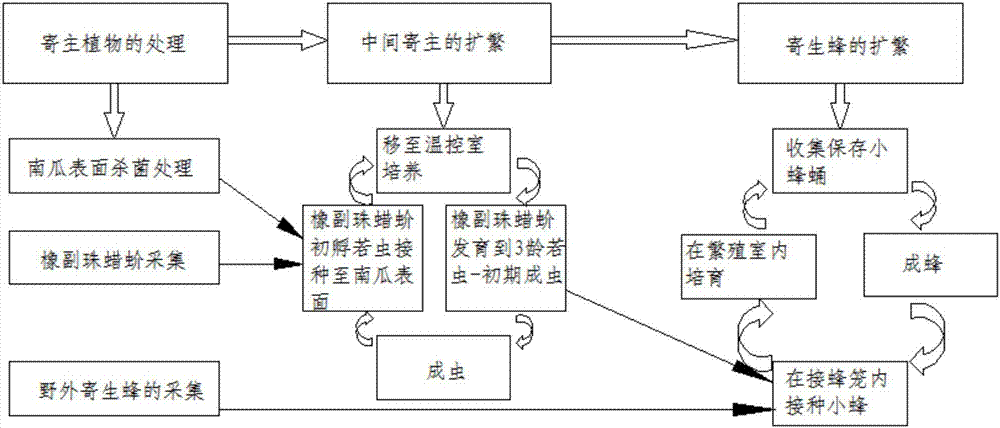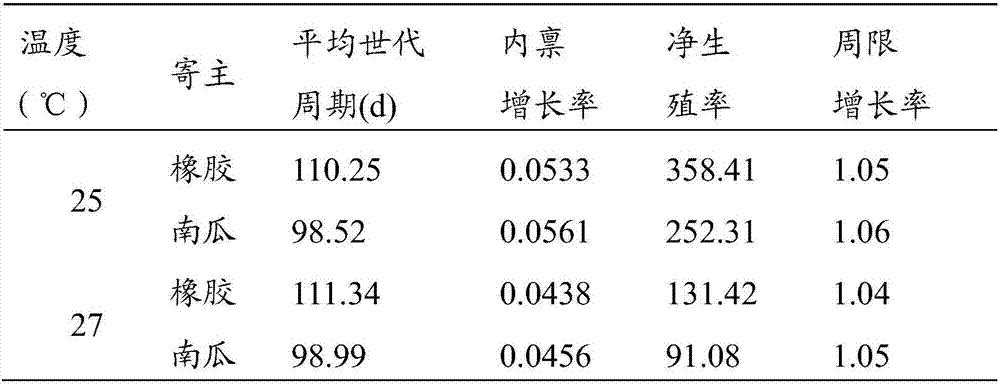A kind of propagation method of Japanese scale-eating wasps
A technology for Scale-eating wasps and parasitic wasps, which is applied to the propagation field of Japanese Scale-eating wasps, can solve the problems of high cost, low parasitic efficiency, low reproduction efficiency, etc., and achieves improved utilization, prolonged use time, improved effect on survival
- Summary
- Abstract
- Description
- Claims
- Application Information
AI Technical Summary
Problems solved by technology
Method used
Image
Examples
Embodiment 1
[0033] Such as figure 1 Shown: a kind of propagation method of Japanese scale-eating wasps, comprising the following steps:
[0034] (1) Treatment of host plants
[0035] Select 3 catties / a complete and mature pumpkin as the host plant, clean the surface with a wet rag, and dry it for later use; mix 70% thiophanate-methyl wettable powder with water to make a 1000-fold medicinal solution; soak the medicinal solution with a rag to treat the pumpkin Disinfect and sterilize the surface, dry it, and place it for 2 days for later use.
[0036] (2) Expansion of intermediate hosts
[0037] Select the rubber paraglycine as the intermediate host; collect the rubber branches with the adults of the paraglycine in the oviposition period (and the newly hatched nymphs crawl out from the adult shell) in the field; put them into the light-proof box with only the upper surface opening For propagation, put a few fresh rubber leaves on the rubber branches; collect the newly hatched nymphs of La...
Embodiment 2
[0041] Such as figure 1 Shown: a kind of propagation method of Japanese scale-eating wasps, comprising the following steps:
[0042] (1) Treatment of host plants
[0043] Pick every 5 jin / one complete and mature pumpkin as the host plant, clean the surface with a wet rag, and dry it for later use; mix 70% thiophanate-methyl wettable powder with water to make a 1000-fold medicinal solution; soak the medicinal solution with a rag to treat the pumpkin The surface is disinfected and sterilized, and left to dry for 3 days;
[0044] (2) Expansion of intermediate hosts
[0045]Select the rubber paraglycine as the intermediate host; collect the rubber branches with the adults of the paraglycine in the oviposition period (and the newly hatched nymphs crawl out from the adult shell) in the field; put them into the light-proof box with only the upper surface opening For propagation, put a few fresh rubber leaves on the rubber branches; collect the newly hatched nymphs of Laxococcus ae...
Embodiment 3
[0049] Such as figure 1 Shown: a kind of propagation method of Japanese scale-eating wasps, comprising the following steps:
[0050] (1) Treatment of host plants
[0051] Select every 4 catties / one complete and mature pumpkin as the host plant, clean the surface with a wet rag, and dry it for later use; mix 70% thiophanate-methyl wettable powder with water to make a 1000-fold medicinal solution; soak the medicinal solution with a rag to treat the pumpkin The surface is disinfected and sterilized, and left to dry for 2.5 days;
[0052] (2) Expansion of intermediate hosts
[0053] Select the rubber paraglycine as the intermediate host; collect the rubber branches with the adults of the paraglycine in the oviposition period (and the newly hatched nymphs crawl out from the adult shell) in the field; put them into the light-proof box with only the upper surface opening For propagation, put a few fresh rubber leaves on the rubber branches; collect the newly hatched nymphs of Laxoc...
PUM
 Login to View More
Login to View More Abstract
Description
Claims
Application Information
 Login to View More
Login to View More - R&D
- Intellectual Property
- Life Sciences
- Materials
- Tech Scout
- Unparalleled Data Quality
- Higher Quality Content
- 60% Fewer Hallucinations
Browse by: Latest US Patents, China's latest patents, Technical Efficacy Thesaurus, Application Domain, Technology Topic, Popular Technical Reports.
© 2025 PatSnap. All rights reserved.Legal|Privacy policy|Modern Slavery Act Transparency Statement|Sitemap|About US| Contact US: help@patsnap.com



